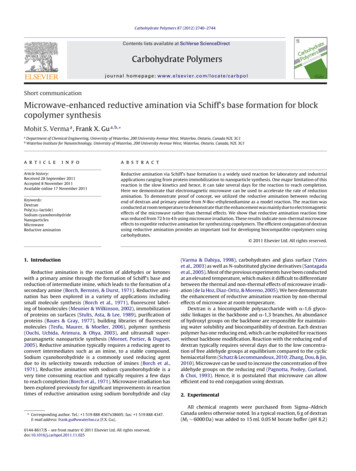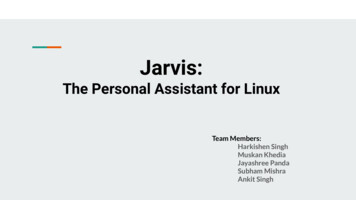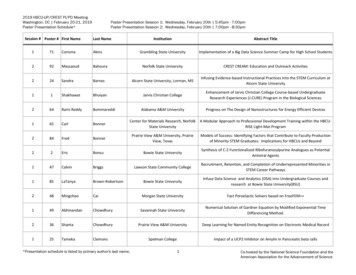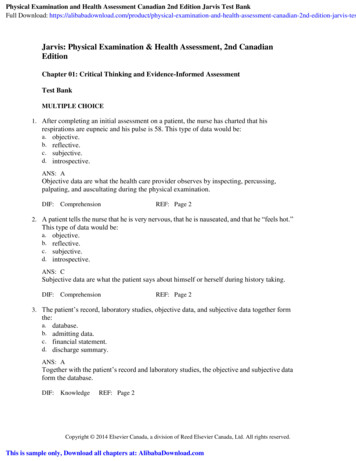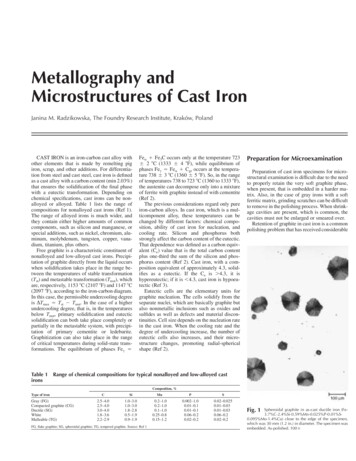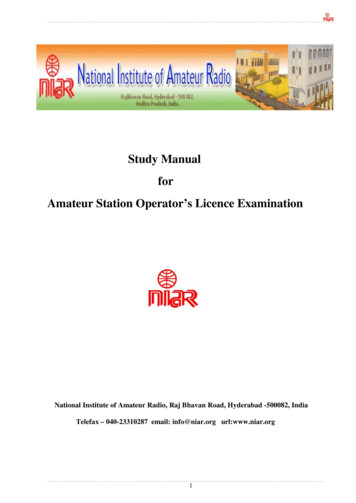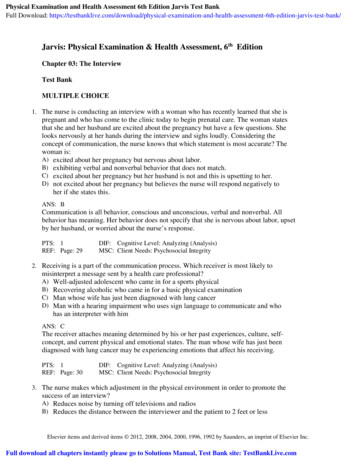
Transcription
Physical Examination and Health Assessment 6th Edition Jarvis Test BankFull Download: -bank/Jarvis: Physical Examination & Health Assessment, 6th EditionChapter 03: The InterviewTest BankMULTIPLE CHOICE1. The nurse is conducting an interview with a woman who has recently learned that she ispregnant and who has come to the clinic today to begin prenatal care. The woman statesthat she and her husband are excited about the pregnancy but have a few questions. Shelooks nervously at her hands during the interview and sighs loudly. Considering theconcept of communication, the nurse knows that which statement is most accurate? Thewoman is:A) excited about her pregnancy but nervous about labor.B) exhibiting verbal and nonverbal behavior that does not match.C) excited about her pregnancy but her husband is not and this is upsetting to her.D) not excited about her pregnancy but believes the nurse will respond negatively toher if she states this.ANS: BCommunication is all behavior, conscious and unconscious, verbal and nonverbal. Allbehavior has meaning. Her behavior does not specify that she is nervous about labor, upsetby her husband, or worried about the nurse’s response.PTS: 1REF: Page: 29DIF: Cognitive Level: Analyzing (Analysis)MSC: Client Needs: Psychosocial Integrity2. Receiving is a part of the communication process. Which receiver is most likely tomisinterpret a message sent by a health care professional?A) Well-adjusted adolescent who came in for a sports physicalB) Recovering alcoholic who came in for a basic physical examinationC) Man whose wife has just been diagnosed with lung cancerD) Man with a hearing impairment who uses sign language to communicate and whohas an interpreter with himANS: CThe receiver attaches meaning determined by his or her past experiences, culture, selfconcept, and current physical and emotional states. The man whose wife has just beendiagnosed with lung cancer may be experiencing emotions that affect his receiving.PTS: 1REF: Page: 30DIF: Cognitive Level: Analyzing (Analysis)MSC: Client Needs: Psychosocial Integrity3. The nurse makes which adjustment in the physical environment in order to promote thesuccess of an interview?A) Reduces noise by turning off televisions and radiosB) Reduces the distance between the interviewer and the patient to 2 feet or lessElsevier items and derived items 2012, 2008, 2004, 2000, 1996, 1992 by Saunders, an imprint of Elsevier Inc.Full download all chapters instantly please go to Solutions Manual, Test Bank site: TestBankLive.com
Test Bank3-2C) Provides a dim light that makes a room cozier and will help the patient relaxD) Arranges seating across a desk or table to allow the patient some personal spaceANS: AThe nurse should reduce noise by turning off the television, radio, and other unnecessaryequipment because multiple stimuli are confusing. The interviewer and patient should beabout 4 to 5 feet apart; the room should be well-lit so that the interviewer and patient cansee each other clearly. Having a table or desk in between the two people creates the idea ofa barrier; equal-status seating, at eye level, is better.PTS: 1REF: Page: 31DIF: Cognitive Level: Applying (Application)MSC: Client Needs: Psychosocial Integrity4. In an interview, the nurse may find it necessary to take notes to aid his or her memorylater. Which statement is true regarding note-taking?A) Note-taking may impede the nurse’s observation of the patient’s nonverbalbehaviors.B) Note-taking allows the patient to continue at his or her own pace as the nurserecords what is said.C) Note-taking allows the nurse to shift attention away from the patient, resulting inan increased comfort level.D) Note-taking allows the nurse to break eye contact with the patient, which mayincrease his or her level of comfort.ANS: ASome use of history forms and note-taking may be unavoidable. But be aware that notetaking during the interview has disadvantages. It breaks eye contact too often, and it shiftsattention away from the patient, which diminishes his or her sense of importance. It alsomay interrupt the patient’s narrative flow, and it impedes the observation of the patient’snonverbal behavior.PTS: 1REF: Page: 31DIF: Cognitive Level: Understanding (Comprehension)MSC: Client Needs: Psychosocial Integrity5. The nurse asks, “I would like to ask you some questions about your health and your usualdaily activities so that we can better plan your stay here.” This question is found at thephase of the interview process.A) summaryB) closingC) bodyD) opening or introductionANS: DWhen gathering a complete history, the nurse should give the reason for the interviewduring the opening or introduction of the interview, not during or at the end of theinterview.PTS: 1REF: Page: 32DIF: Cognitive Level: Understanding (Comprehension)MSC: Client Needs: Psychosocial IntegrityElsevier items and derived items 2012, 2008, 2004, 2000, 1996, 1992 by Saunders, an imprint of Elsevier Inc.
Test Bank3-36. A woman has just entered the emergency department after being battered by her husband.The nurse needs to get some information from her to begin treatment. What is the bestchoice for an opening with this patient?A) “Hello Nancy, my name is Mrs. C.”B) “Hello, Mrs. H., my name is Mrs. C. It sure is cold today!”C) “Mrs. H., my name is Mrs. C. How are you?”D) “Mrs. H., my name is Mrs. C. I’ll need to ask you a few questions about whathappened.”ANS: DAddress the person by using his or her surname. The nurse should introduce himself orherself and give the reason for the interview. Friendly small talk is not needed to buildrapport.PTS: 1REF: Page: 32DIF: Cognitive Level: Applying (Application)MSC: Client Needs: Psychosocial Integrity7. During an interview, the nurse states, “You mentioned shortness of breath. Tell me moreabout that.” Which verbal skill is used with this statement?A) ReflectionB) FacilitationC) Direct questionD) Open-ended questionANS: DThe open-ended question asks for narrative information. It states the topic to be discussedbut only in general terms. The nurse should use it to begin the interview, to introduce anew section of questions, and whenever the person introduces a new topic.PTS: 1REF: Page: 32DIF: Cognitive Level: Understanding (Comprehension)MSC: Client Needs: Psychosocial Integrity8. A patient has finished giving the nurse information about the reason he is seeking care.When reviewing the data, the nurse finds that some information about past hospitalizationsis missing. At this point, which statement by the nurse would be most appropriate togather these data?A) “Mr. Y., at your age, surely you have been hospitalized before!”B) “Mr. Y., I just need permission to get your medical records from County Medical.”C) “Mr. Y., you mentioned that you have been hospitalized on several occasions.Would you tell me more about that?”D) “Mr. Y., I just need to get some additional information about your pasthospitalizations. When was the last time you were admitted for chest pain?”ANS: DThe nurse should use direct questions after the person’s opening narrative to fill in anydetails he or she left out. The nurse also should use direct questions when specific facts areneeded, such as when asking about past health problems or during the review of systems.Elsevier items and derived items 2012, 2008, 2004, 2000, 1996, 1992 by Saunders, an imprint of Elsevier Inc.
Test BankPTS: 1REF: Page: 323-4DIF: Cognitive Level: Applying (Application)MSC: Client Needs: Psychosocial Integrity9. In using verbal responses to assist the patient’s narrative, some responses focus on thepatient’s frame of reference and some focus on the health care provider’s perspective. Anexample of a verbal response that focuses on the health care provider’s perspective wouldbe:A) empathy.B) reflection.C) facilitation.D) confrontation.ANS: DWhen the health care provider uses the response of confrontation, the frame of referenceshifts from the patient’s perspective to the health care provider’s, and the health careprovider starts to express his or her own thoughts and feelings. Empathy, reflection, andfacilitation responses focus on the patient’s frame of reference.PTS: 1DIF: Cognitive Level: Remembering (Knowledge)REF: Pages: 34-35 MSC: Client Needs: Psychosocial Integrity10. When taking a history from a newly admitted patient, the nurse notices that he is pausingoften and looking at the nurse expectantly. What would be the nurse’s best response to thisbehavior?A) Be silent and allow him to continue when he is ready.B) Smile at him and say, “Don’t worry about all of this. I’m sure we can find out whyyou’re having these pains.”C) Lean back in the chair and ask, “You are looking at me kind of funny; there isn’tanything wrong, is there?”D) Stand up and say, “I can see that this interview is uncomfortable for you. We cancontinue it another time.”ANS: ASilent attentiveness communicates that the person has time to think, to organize what he orshe wishes to say without interruption from the nurse. This “thinking silence” is the onehealth professionals interrupt most often. The other responses are not conducive to idealcommunication.PTS: 1REF: Page: 34DIF: Cognitive Level: Applying (Application)MSC: Client Needs: Psychosocial Integrity11. A woman is discussing the problems she is having with her 2-year-old son. She says, “Hewon’t go to sleep at night, and during the day he has several fits. I get so upset when thathappens.” The nurse’s best verbal response would be:A) “Go on, I’m listening.”B) “Fits? Tell me what you mean by this.”C) “Yes, it can be upsetting when a child has a fit.”D) “Don’t be upset when he has a fit; every 2-year-old has fits.”Elsevier items and derived items 2012, 2008, 2004, 2000, 1996, 1992 by Saunders, an imprint of Elsevier Inc.
Test Bank3-5ANS: BUse clarification when the person’s word choice is ambiguous or confusing (e.g., “Tell mewhat you mean by ‘fits.’”). Clarification is also used to summarize the person’s words,simplify the words to make them clearer, and then ask if you are on the right track.PTS: 1REF: Page: 34DIF: Cognitive Level: Applying (Application)MSC: Client Needs: Psychosocial Integrity12. A 17-year-old single mother is describing how difficult it is to raise a 3-year-old child byherself. During the course of the interview she states, “I can’t believe my boyfriend leftme to do this by myself! What a terrible thing to do to me!” Which of these responses bythe nurse uses empathy?A) “You feel alone.”B) “You can’t believe he left you alone?”C) “It must be so hard to face this all alone.”D) “I would be angry, too; raising a child alone is no picnic.”ANS: CAn empathetic response recognizes the feeling and puts it into words. It names the feelingand allows the expression of it. It strengthens rapport. Other empathetic responses are,“This must be very hard for you,” “I understand,” or just placing your hand on theperson’s arm. Simply reflecting the person’s words is not an empathetic response, nor isagreeing with the person.PTS: 1REF: Page: 34DIF: Cognitive Level: Applying (Application)MSC: Client Needs: Psychosocial Integrity13. A man has been admitted to the observation unit for observation after being treated for alarge cut on his forehead. As the nurse works through the interview, one of the standardquestions has to do with alcohol, tobacco, and drug use. When the nurse asks him abouttobacco use, he states, “I quit smoking after my wife died 7 years ago.” However, thenurse notices an open package of cigarettes in his shirt pocket. Using confrontation, thenurse could say:A) “Mr. K., I know that you are lying.”B) “Mr. K., come on, tell me how much you smoke.”C) “Mr. K., I didn’t realize your wife had died. It must be difficult for you at thistime. Please tell me more about that.”D) “Mr. K., you have said that you don’t smoke, but I see that you have an openpackage of cigarettes in your pocket.”ANS: DIn the case of confrontation, a certain action, feeling, or statement has been observed, andthe nurse now focuses the patient’s attention on it. The nurse should give honest feedbackabout what is seen or felt. This may focus on a discrepancy. Or the nurse may confront thepatient when parts of the story are inconsistent. The other statements are not appropriate.PTS: 1REF: Page: 35DIF: Cognitive Level: Applying (Application)MSC: Client Needs: Psychosocial IntegrityElsevier items and derived items 2012, 2008, 2004, 2000, 1996, 1992 by Saunders, an imprint of Elsevier Inc.
Test Bank3-614. The nurse has used interpretation regarding a patient’s statement or actions. After usingthis technique, it would be best for the nurse to:A) apologize because this can be demeaning for the patient.B) allow the patient time to confirm or correct the inference.C) continue with the interview as though nothing has happened.D) immediately restate the nurse’s conclusion on the basis of the patient’s nonverbalresponse.ANS: BInterpretation is not based on direct observation as is confrontation, but it is based onone’s inference or conclusion. The nurse risks making the wrong inference. If this is thecase, the patient will correct it. But even if the inference is corrected, interpretation helpsto prompt further discussion of the topic.PTS: 1REF: Page: 35DIF: Cognitive Level: Analyzing (Analysis)MSC: Client Needs: Psychosocial Integrity15. During an interview, a woman says, “I have decided that I can no longer allow mychildren to live with their father’s violence, but I just can’t seem to leave him.” Usinginterpretation, the nurse’s best response would be:A) “You are going to leave him?”B) “If you are afraid for your children, then why can’t you leave?”C) “It sounds as if you might be afraid of how your husband will respond.”D) “It sounds as though you have made your decision. I think it is a good one.”ANS: CThis statement is not based on one’s inference or conclusion. It links events, makesassociations, or implies cause. Interpretation also ascribes feelings and helps the personunderstand his or her own feelings in relation to the verbal message. The other statementsdo not reflect interpretation.PTS: 1REF: Page: 35DIF: Cognitive Level: Applying (Application)MSC: Client Needs: Psychosocial Integrity16. A pregnant woman states, “I just know labor will be so painful that I won’t be able tostand it. I know it sounds awful, but I really dread going into labor.” The nurse respondsby stating, “Oh, don’t worry about labor so much. I have been through it, and although itis painful there are many good medications to decrease the pain.” Which statement is trueregarding this response? It was a:A) therapeutic response. By sharing something personal, the nurse gives hope to thiswoman.B) nontherapeutic response. By providing false reassurance, the nurse actually cut offfurther discussion of the woman’s fears.C) therapeutic response. By providing information about the medications available,the nurse is giving information to the woman.D) nontherapeutic response. The nurse is essentially giving the message to the womanthat labor cannot be tolerated without medication.ANS: BElsevier items and derived items 2012, 2008, 2004, 2000, 1996, 1992 by Saunders, an imprint of Elsevier Inc.
Test Bank3-7By providing false assurance or reassurance, this “courage builder” relieves one’s anxietyand gives the nurse the false sense of having provided comfort. But for the woman, itactually closes off communication. It trivializes her anxiety and effectively denies anyfurther talk of it.PTS: 1REF: Page: 35DIF: Cognitive Level: Analyzing (Analysis)MSC: Client Needs: Psychosocial Integrity17. During a clinic visit a patient states, “The doctor just told me he thought I ought to stopsmoking. He doesn’t understand how hard I’ve tried. I just don’t know the best way to doit. What should I do?” The nurse’s most appropriate response in this case would be:A) “I’d quit. The doctor really knows what he is talking about.”B) “Would you like some information about the different ways a person can quitsmoking?”C) “Stopping your dependence on cigarettes can be very difficult. I understand howyou feel.”D) “Why are you confused? Didn’t the doctor give you the information about thesmoking cessation program we offer?”ANS: BUse clarification when the person’s word choice is ambiguous or confusing. Clarificationis also used to summarize the person’s words, simplify the words to make them clearer,and then ask if you are on the right track. The other responses give unwanted advice or donot offer a helpful response.PTS: 1REF: Page: 34DIF: Cognitive Level: Applying (Application)MSC: Client Needs: Psychosocial Integrity18. As the nurse enters a patient’s room, the nurse finds her crying. The patient states that shehas just found out that the lump in her breast is cancer and says, “I’m so afraid of, um, youknow.” The nurse’s most therapeutic response would be to say, in a gentle manner:A) “You’re afraid you might lose your breast?”B) “No, I’m not sure what you are talking about.”C) “I’ll wait here until you get yourself under control and then we can talk.”D) “I can see that you are very upset. Perhaps we should discuss this later.”ANS: AReflection echoes the patient’s words, repeating part of what the person just said.Reflection also can help express the feeling behind a person’s words.PTS: 1REF: Page: 34DIF: Cognitive Level: Applying (Application)MSC: Client Needs: Psychosocial Integrity19. A nurse is taking complete health histories on all of the patients attending a wellnessworkshop. On the history form, one of the written questions asks, “You don’t smoke,drink, or take drugs, do you?” This question is an example of:A) talking too much.B) using confrontation.Elsevier items and derived items 2012, 2008, 2004, 2000, 1996, 1992 by Saunders, an imprint of Elsevier Inc.
Test Bank3-8C) using biased or leading questions.D) using blunt language to deal with distasteful topics.ANS: CThis is an example of using leading or biased questions. Asking, “You don’t smoke, doyou?” implies that one answer is “better” than another. If the person wants to pleasesomeone, he or she is either forced to answer in a way corresponding to their impliedvalues or is made to feel guilty when admitting the other answer.PTS: 1REF: Page: 36DIF: Cognitive Level: Understanding (Comprehension)MSC: Client Needs: Psychosocial Integrity20. When observing a patient’s verbal and nonverbal communication, the nurse notices adiscrepancy. Which statement is true regarding this situation? The nurse should:A) ask someone who knows the patient well to help interpret this discrepancy.B) focus on the patient’s verbal message and try to ignore the nonverbal behaviors.C) try to integrate the verbal and nonverbal messages and then interpret them as an“average.”D) focus on the patient’s nonverbal behaviors because these are often more reflectiveof a patient’s true feelings.ANS: DWhen nonverbal and verbal messages are congruent, the verbal message is reinforced.When they are incongruent, the nonverbal message tends to be the true one because it isunder less conscious control. Thus it is important to study the nonverbal messages ofpatients and examiners and to understand their meanings. The other statements are nottrue.PTS: 1REF: Page: 36DIF: Cognitive Level: Applying (Application)MSC: Client Needs: Psychosocial Integrity21. During an interview, a parent of a hospitalized child is sitting in an open position. As theinterviewer begins to discuss his son’s treatment, however, he suddenly crosses his armsagainst his chest and crosses his legs. This would suggest that the parent is:A) just changing positions.B) more comfortable in this position.C) tired and needs a break from the interview.D) uncomfortable talking about his son’s treatment.ANS: DNote the person’s position. An open position with the extension of large muscle groupsshows relaxation, physical comfort, and a willingness to share information. A closedposition with the arms and legs crossed tends to look defensive and anxious. Note anychange in posture. If a person in a relaxed position suddenly tenses, it suggests possiblediscomfort with the new topic.PTS: 1REF: Page: 37DIF: Cognitive Level: Analyzing (Analysis)MSC: Client Needs: Psychosocial IntegrityElsevier items and derived items 2012, 2008, 2004, 2000, 1996, 1992 by Saunders, an imprint of Elsevier Inc.
Test Bank3-922. A mother brings her 28-month-old daughter into the clinic for a well-child visit. At thebeginning of the visit, the nurse focuses attention away from the toddler, but as theinterview progresses, the toddler begins to “warm up” and is smiling shyly at the nurse.The nurse will be most successful in interacting with the toddler if which is done next?A) Tickle the toddler and get her to laugh.B) Stoop down to her level and ask her about the toy she is holding.C) Continue to ignore her until it is time for the physical examination.D) Ask the mother to leave during the examination of the toddler because toddlersoften fuss less if their parents aren’t in view.ANS: BAlthough most of the communication is with the parent, the nurse should not ignore thechild completely. Making contact will assist in easing into the physical examination later.The nurse should begin by asking about the toys the child is playing with or about aspecial doll or teddy bear brought from home: “Does your doll have a name?” or “Whatcan your truck do?” Stoop down to meet the child at his or her eye level.PTS: 1REF: Page: 38DIF: Cognitive Level: Applying (Application)MSC: Client Needs: Psychosocial Integrity23. During an examination of a 3-year-old child, the nurse will need to take her bloodpressure. What might the nurse do to try to gain the child’s full cooperation?A) Tell the child that the blood pressure cuff is going to give her arm a big hug.B) Tell the child that the blood pressure cuff is asleep and cannot wake up.C) Give the blood pressure cuff a name and refer to it by this name during theassessment.D) Tell the child that by using the blood pressure cuff, we can see how strong hermuscles are.ANS: DUse short, simple sentences with a concrete explanation. Take time to give a short, simpleexplanation for any unfamiliar equipment that will be used on the child. Preschoolers areanimistic; they imagine inanimate objects can come alive and have human characteristics.Thus a blood pressure cuff can wake up and bite or pinch.PTS: 1REF: Page: 39DIF: Cognitive Level: Applying (Application)MSC: Client Needs: Psychosocial Integrity24. A 16-year-old boy has just been admitted to the unit for overnight observation after beingin an automobile accident. What is the nurse’s best approach to communicating with him?A) Use periods of silence to communicate respect for him.B) Be totally honest with him, even if the information is unpleasant.C) Tell him that everything that is discussed will be kept totally confidential.D) Use slang language when possible to help him open up.ANS: BElsevier items and derived items 2012, 2008, 2004, 2000, 1996, 1992 by Saunders, an imprint of Elsevier Inc.
Test Bank3-10Successful communication (with adolescents) is possible and rewarding. The guidelinesare simple. The first consideration is one’s attitude, which must be one of respect. Second,communication must be totally honest. Adolescents’ intuition is highly tuned and candetect phoniness or withholding of information. Always give them the truth.PTS: 1REF: Page: 39DIF: Cognitive Level: Applying (Application)MSC: Client Needs: Psychosocial Integrity25. A 75-year-old woman is at the office for a preoperative interview. The nurse is aware thatthe interview may take longer than interviews with younger persons. What is the reasonfor this?A) An aged person has a longer story to tell.B) An aged person is usually lonely and likes to have someone with whom to talk.C) Aged persons lose much of their mental abilities and require greater time tocomplete an interview.D) As a person ages, he or she is unable to hear; thus, interviewers usually need torepeat much of what is said.ANS: AThe interview usually takes longer with older adults because they have a longer story totell. It is not necessarily true that all older adults are lonely, have lost mental abilities, orare hard of hearing.PTS: 1REF: Page: 40DIF: Cognitive Level: Understanding (Comprehension)MSC: Client Needs: Psychosocial Integrity26. The nurse is interviewing a patient who has a hearing impairment. What techniques wouldbe most beneficial in communicating with this patient?A) Determine the communication method he prefers.B) Avoid using facial and hand gestures because most hearing-impaired people findthis degrading.C) Request a sign language interpreter before meeting with him to help facilitate thecommunication.D) Speak loudly and with exaggerated facial movement when talking with himbecause this helps with lip reading.ANS: AThe nurse should ask the deaf person the preferred way to communicate—by signing, lipreading, or writing. If the person prefers lip reading, then the nurse should be sure to facehim or her squarely and have good lighting on the nurse’s face. The nurse should notexaggerate lip movements because this distorts words. Similarly, shouting distorts thereception of a hearing aid the person may wear. The nurse should speak slowly and shouldsupplement his or her voice with appropriate hand gestures or pantomime.PTS: 1DIF: Cognitive Level: Understanding (Comprehension)REF: Pages: 40-41 MSC: Client Needs: Psychosocial IntegrityElsevier items and derived items 2012, 2008, 2004, 2000, 1996, 1992 by Saunders, an imprint of Elsevier Inc.
Test Bank3-1127. During a prenatal check, a patient begins to cry as the nurse asks her about previouspregnancies. She states that she is remembering her last pregnancy, which ended inmiscarriage. The nurse’s best response to her crying would be:A) “I’m so sorry for making you cry!”B) “I can see that you are sad remembering this. It is all right to cry.”C) “Why don’t I step out for a few minutes until you’re feeling better?”D) “I can see that you feel sad about this; why don’t we talk about something else?”ANS: BA beginning examiner usually feels horrified when the patient starts crying. When thenurse says something that “makes the person cry,” the nurse should not think he or she hashurt the person. The nurse has just hit on a topic that is important, so it is important not togo on to a new topic. The nurse should allow the person to cry and express his or herfeelings fully. The nurse can offer a tissue and wait until the crying subsides to talk.PTS: 1DIF: Cognitive Level: Applying (Application)REF: Pages: 41-42 MSC: Client Needs: Psychosocial Integrity28. A female nurse is interviewing a male who has recently immigrated. During the course ofthe interview, he leans forward and then finally moves his chair close enough that hisknees are nearly touching the nurse’s knees. The nurse begins to feel uncomfortable withhis proximity. Which statement most closely reflects what the nurse should do next?A) Try to relax—these behaviors are culturally appropriate for this person.B) Discreetly move one’s chair back until the distance is more comfortable and thencontinue with the interview.C) These behaviors are indicative of sexual aggression, and the nurse should confrontthis person about them.D) The nurse should laugh but tell him that he or she is uncomfortable with hisproximity and ask him to move away.ANS: ABoth the patient’s and the nurse’s sense of spatial distance are significant throughout theinterview and physical examination, with culturally appropriate distance zones varyingwidely. Some cultural groups value close physical proximity and may perceive a healthcare provider who is distancing himself or herself as being aloof and unfriendly.PTS: 1DIF: Cognitive Level: Analyzing (Analysis)REF: Pages: 43-44 MSC: Client Needs: Psychosocial Integrity29. An American Indian woman has come to the clinic for diabetic follow-up teaching.During the interview, the nurse notices that she never makes eye contact and speaksmostly to the floor. Which statement is true regarding this situation?A) She is nervous and embarrassed.B) She has something to hide and is ashamed.C) She is showing inconsistent verbal and nonverbal behaviors.D) She is showing that she is listening carefully to what the nurse is saying.ANS: DElsevier items and derived items 2012, 2008, 2004, 2000, 1996, 1992 by Saunders, an imprint of Elsevier Inc.
Test Bank3-12Eye contact is perhaps among the most culturally variable nonverbal behaviors. Asian,American Indian, Indochinese, Arabian, and Appalachian people may consider direct eyecontact impolite or aggressive, and they may avert their eyes during the interview.American Indians often stare at the floor during the interview, which is a culturallyappropriate behavior indicating that the listener is paying close attention to the speaker.PTS: 1REF: Page: 48DIF: Cognitive Level: Analyzing (Analysis)MSC: Client Needs: Psychosocial Integrity30. The nurse has just started an assessment of a newborn child of a Vietnamese mother.Considering the mother’s cultural background, which statement is true regarding thisexamination? The mother:A) will be offended if the infant’s fontanel is examined.B) will be offended if the infant’s diaper area is touched during the examination.C) would prefer to have the results of the examination communicated directly to herhusband.D) would prefer to receive written material about growth and development rather thana verbal explanation.ANS: ATouching children may have associated meaning cross-culturally. Many Asians believethat one’s strength resides in the head and touching the head is considered disrespectful.Thus, palpating the fontanel of an infant from Southeast Asian descent should beapproached with sensitivity.PTS: 1REF: Page: 48DIF: Cognitive Lev
Jarvis: Physical Ex amination & Health Assessment, 6. th. Edition . Chapter 03: The Interview . Test Bank. MULTIPLE CHOICE. 1. The nurse is conducting an interview with a woman who has recently learned that she is pregnant and who has come to the clinic today to begin prenatal care. The woman states
